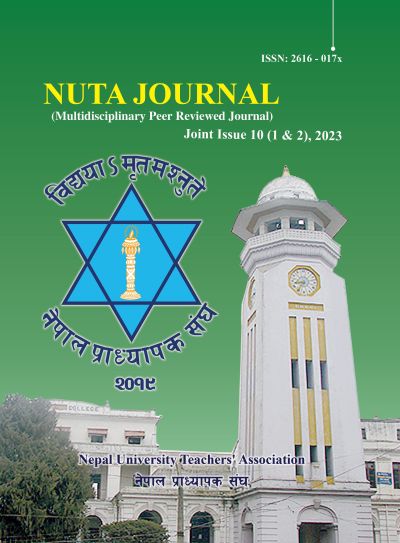सुरेल जातिका लोकदेवीदेवता एवम् पूजा–उपासना विधि {Surel caste's folk goddesses and worship methods}
DOI:
https://doi.org/10.3126/nutaj.v10i1-2.63076Keywords:
सुरेल जाती, बसोबास, जनसंख्या, देवीदेवता, उपासना विधि, Surel caste, settlement, population, deities, method of worshipAbstract
दोलखा जिल्लाको सुरी गाउँमा बसोबास गर्ने सुरेल जातिका लोकदेवीदेवता एवम् पूजा उपासना विधिको अध्ययनमा यो लेख केन्द्रित छ । मूलतः हिन्दू धर्म मान्ने यो जातिका सांस्कृतिक परम्पराहरू धार्मिक मूल्यमान्यता र विश्वासबाटै निर्देशित छन् । लोकदेवीदेवता एवम् पूजा उपासना विधि पनि आफ्नै प्रकारका छन् । भूमे, इवी, बम्वु, श्रीढोल, श्रीचन्द, जसिढोल, इतितढो, आइतवारे, रेल, गङ्गा, किर्किस्तानी, सेलीभूमे, सेतीदेवी, सेतीनाग, कोमलामाई, बासि जस्ता देवीदेवतालाई यिनीहरू कुलदेवता, पितृदेवता तथा स्थानीय देउदेउताका रूपमा भक्तिभावका साथ पूजाउपासना गर्ने गर्दछन् । विशेषतः वर्षको दुई पटक उभौली र उधौलीमा उक्त देउदेउताको पूजाउपासना धुमधामका साथ गर्ने परम्परा छ । यसबाहेक यिनीहरूका विभिन्न प्रकारका मौलिक चाडबाड, पर्व तथा उत्सव मनाउँदा, संस्कारगत अनुष्ठानहरू सम्पादन गर्दा र गाउँटोल तथा घरपरिवारमा अनिष्ट आइलाग्दा पनि यिनीहरू कुलदेवता, पितृदेवता तथा स्थानीय देउदेउताप्रति श्रद्धाभक्तिसहित पूजाउपासना गर्ने गर्दछन् । सुरेल जाति को हुन् ? यिनीहरूको उत्पत्ति कसरी भयो ? यिनीहरूलाई सुरेल किन भनियो ? यिनीहरूका देवीदेवता तिनको पूजाउपासना विधि कस्तो छ ? भन्ने जस्ता प्रश्नहरूको सम्बोधन गर्ने उद्देश्यबाट यस जातिको विषयमा आजसम्म उति धेरै अध्ययन अनुसन्धान हुन सकेको छैन । जति सोधखोज भएका छन्, ती कार्यहरूले पनि माथि उल्लिखित जिज्ञासाहरूलाई पूर्णरूपमा सम्बोधन गर्न नसकेको देखिन्छ । अतः यस लेखमा सुरेल जातिका लोकदेवीदेवता एवम् पूजा उपासना विधिलाई अध्ययनको समस्याका रूपमा पहिचान गरिएको हो । उक्त पक्षको पहिचान तथा विश्लेषण गर्ने विशिष्ट उद्देश्य प्राप्तिका निमित्त यो अध्ययन गरिएको छ । यस लेखमा प्राथमिक तथा द्वितीयक दुवै प्रकृति तथा स्रोतका तथ्याङ्कहरू विश्लेषण गरिएका छन् । प्राथमिक तथ्याङ्क कार्यक्षेत्र अध्ययनबाट सङ्कलन गरिएका हुन् । द्वितीयक सूचना भने पूर्वकार्यको समीक्षाबाट सङ्कलन गरिएको हो । यो लेख गुणात्मक ढाँचामा आधारित छ । {This article focuses on the study of folk goddesses and gods and worship methods of Surel caste living in Suri village of Dolakha district. The cultural traditions of this caste, who basically follow Hinduism, are guided by religious values and beliefs. Folk goddesses and worship methods also have their own types.They worship deities like Bhume, Eevi, Bamvu, Sridhol, Srichand, Jasidhol, Ititdho, Aitaware, Rail, Ganga, Kirkistani, Selibhume, Setidevi, Setinag, Komalamai, Basi as the kula deity, patriarch deity and local deities with devotion. Especially, twice a year in Ubhauli and Udhauli, there is a tradition of worshiping the deity with pomp.Apart from this, when they celebrate different types of original festivals, festivals and celebrations, perform ritual rituals and even when disaster strikes the village and family, they worship with devotion to the patriarchal deities, patriarchal deities and local deities. Who is Surel Jati? How did they originate? Why are they called Surel? What is the method of worshiping their gods and goddesses? Until now, not much research has been done on the subject of this caste with the aim of addressing such questions. As much as the inquiries have been made, it seems that even those works have not been able to fully address the above-mentioned inquiries. Therefore, in this article, folk goddesses and gods and worship methods of Surel caste have been identified as problems of study.This study has been conducted for the specific purpose of identifying and analyzing that aspect. In this article, data of both primary and secondary nature and sources have been analyzed. Primary data were collected from field studies. Secondary information is collected from the review of previous work. This article is based on a qualitative approach.}
Downloads
Downloads
Published
How to Cite
Issue
Section
License
© Copyright by NUTA JOURNAL
All Rights Reserved. No part of this Journal may be reproduced in any form or by any electronic or mechanical means, including information storage and retrieval system without prior permission in writing from the publisher, except by a reviewer who may quote brief extracts while reviewing.

